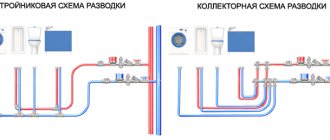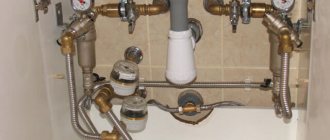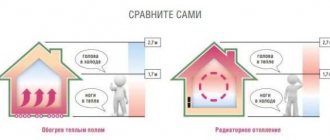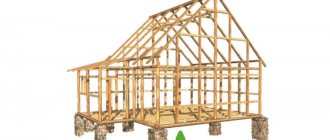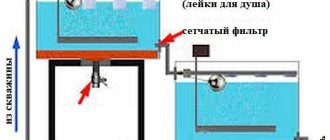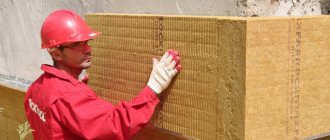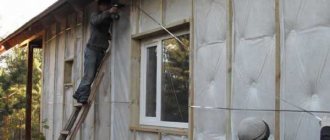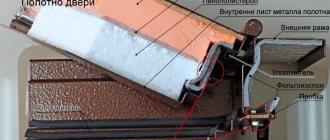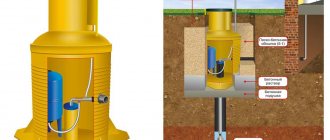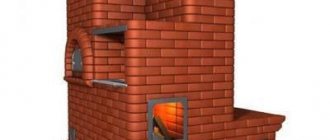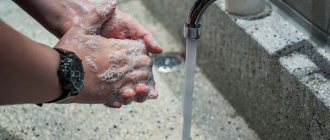We carry water from the well to the house
- You will have to build a well or borehole at your own expense (if the city authorities dig them, you will have to pay for water at the standard rate);
- It is necessary to have a pit, well or septic tank for sewerage - without them, water supply is neither urban nor autonomous;
- To find water, you will have to use the services of a specialist, and within the city limits you will also have to check the building plans for the laying of various communications;
- It is advisable to plan the plumbing at the design stage of the house, otherwise you will have to work with limiting factors.
A reasonable alternative to your own system is to connect your house to a nearby city water supply. Before making a final conclusion, know:
- The process is fraught with trips to different authorities and collecting documents;
- You need to order a fresh explication of the entire site from surveyors;
- To apply for connection, a package of documents is collected (the list is provided at the local water utility);
- The period for developing technical specifications for a water supply project takes up to 14 working days (should be done free of charge);
- After receiving the technical specifications, a water supply project is developed, who will be the author, the customer decides, but the finished communications project will have to be approved by the water supply and sewerage sector, distribution network, gas and telephone services - all organizations that have provided their communications to a private house;
The package of documents for an old building is significantly smaller than the package for a building that will be erected or is under construction. Therefore, it is sometimes advised to purchase an old building, but with connected communications, rather than prepare new project documentation and install communications. The final cost amounts to a significant amount
- If the project involves carrying out work near or on the roadway, approval and special permission from the relevant department and the traffic police are required;
- The last stage of project approval is the local architectural department.
Basic rules for designing circuits
You need to know the basic rules for drawing up a wiring diagram in order to correctly and with the necessary preparation carry out the water supply of a private house with your own hands. It is the distribution diagram for hot water supply, as well as for the separate supply of cold water supply, that reflects all the points related to the correct location of the water heater and the places where the water draw-off points are located. It also records where the water supply pipes, valves and passage elements will be located.
In the event that a continuous supply of water is planned from a well, or a well dug in advance near the house, it is necessary to correctly determine the location of the pumping station, filters and reverse valves located directly in this system.
The rules for developing such schemes are not complicated and include the following elements:
- According to all installation rules, the storage tank is connected to the main water pipe. When supplying water through the use of central heating, the pressure will be variable. This means that it is necessary to install an additional pump to ensure stable water pressure.
- Before water enters the container, it is advisable to provide preliminary filtration from foreign impurities and debris.
- When there is no water, the pump is at risk of burning out. A specially installed dry running sensor will ensure that the power is turned off on time.
- In the event that water is supplied from a well, a stable pressure will be ensured by the installed pumping station. It already has built-in burnout protection.
- A float switch is a necessary element in the circuit. It will serve as protection against transfusion.
Connection diagrams
What schemes can be used:
Instantaneous water heater
A scheme using a flow-through heater involves heating water in a specially designated tank or device at a time when water passes through it under pressure.
There are a huge variety of ways to provide flow-through heating by using:
- geyser;
- electric flow heater;
- water supply systems with heating system;
- double-circuit boiler.
In each case, one principle is involved - instant heating of water from heating elements. To make the water hot enough, it is necessary to install very powerful electrical devices or consume a large amount of gas, otherwise the water at the outlet will not reach an acceptable temperature.
The same applies to the number of water distribution points; for example, taking a shower and washing dishes at the same time will be difficult, since not every device can heat a large amount of water at once.
Storage heater
The second method is to install a water heating tank . Cold water flows into it, after which it is heated by the built-in heating element to a specified level. Such a water heating system is superior in price, but guarantees uninterrupted access to water until it runs out in the tank.
The user can choose the tank volume at his own discretion, based on his needs.
You can find two versions of such tanks on sale: with indirect heating and layered. Stratified tanks are also often used in conjunction with instantaneous heaters, while indirect tanks are a completely autonomous water heating system.
Installation of external water supply
Let's consider the main criteria for installing an external water supply system
Freezing depth
Water supply communications are usually laid at depth. To do this, when organizing water supply for a private house, it is necessary to excavate a trench. It is important to take into account the level of its depth when preparing. It directly depends on how deeply the soil freezes, as well as on the temperature to which each specific region is usually exposed at different times of the year. In order to further protect water supply pipes from freezing, it is recommended to use a special thermal insulation layer.
Typical trench for laying water pipes
In this matter, it is necessary to carefully consider the point of exit of the pipeline and take into account the following nuances:
- It is recommended to make a small gap, approximately 130-150 mm on all sides in the place where the hole for installing and welding the water supply pipe is located. The destruction of communications will be minimal if the wall undergoes subsidence or deforms.
- Additional thermal insulation is necessary where the pipe passing between communications is exposed to the open air as a result of an insufficient joint.
Pipe diameter
Choosing a pipe of the correct diameter will make the installation of water supply more economical.
It is necessary to calculate the parameters of the lines that will supply cold water supply and hot water supply branching from it to points of consumption from the starting point - the total length of each line.
Often a pipe with a diameter of 32 mm is laid to the house. In rare cases, a larger diameter is used.
Insulation
In order to insulate the pipeline, it is necessary to use special building materials intended for such work:
- Foam insulation;
- Glass wool;
- Polystyrene “shell”;
- Basalt wool in cylinders.
- Foam rubber
These are the main materials, the choice of which depends on the weather conditions in each individual place, personal preferences and price category.
How to install water in a private house with your own hands
Conducting water to a private house on your own is quite a difficult task, especially when the house has been built a long time ago. However, having running water in a village house or country cottage will make your life much more comfortable, which means your efforts will pay off handsomely. The work of specialists is expensive, but you can install the plumbing yourself.
Water supply diagram in a private house
First you need to draw a diagram of the water supply system. It is very important! It should include the location of all elements: pump, filter, boiler, manifold, taps, as well as the distance between them. All this will help in calculating the required number of pipes for the water supply.
You can lay pipes in the following ways:
- With serial connection of consumers
, that is, one main pipeline is installed in a private house, from which a branch is made to each water consumer. If you open several taps at once, the farthest one will have very weak water pressure. Therefore, it is recommended to use this scheme only in small country houses with one or two people living in them.
- With manifold connection:
A separate pipe is laid from the common collector to each consumer, and therefore the water pressure will be good and almost equal at any point of the intake.
Installing a manifold connection is more difficult and, of course, much more expensive, and its price is directly proportional to the number of pipes used. But if you choose this wiring method, you will not regret it. In the future, we will talk specifically about the collector pipe connection system.
Let's consider a typical scheme for providing water to a private home:
- Source of water intake (well, borehole).
- Pumping station. A pipe is installed between the water source and the pump, on which a check valve is installed so that the water circulates in only one direction.
- A hydraulic accumulator is a container for pumping water.
- Next, a tee is placed on the outlet pipe and a connection is made into two pipes: in one there is water for private needs, in the second - for technical needs (for watering the garden, vegetable garden, car washing, etc.).
- The “home” pipe is connected to a filter system, since underground water may contain harmful impurities.
- After the water purification and water treatment systems, a tee is installed with dilution for cold and hot water.
- The cold water pipe is connected to a cold water collector, from which pipes radiate throughout the private house. A shut-off valve is installed on each line.
- The hot water pipe is connected to the water heater.
- The hot water pipe from the water heater is connected to the hot water collector, and pipes are also drawn from it throughout the entire area of the house.
The number of elements can be supplemented, but in general the connection sequence is always the same.
Source of water intake
Before you start running pipes into your home, be sure to decide what water source you will use and arrange for it.
Water treatment kits in our catalog
- Clarification/deferrization filter
RUB 3,081. - Clarification/deferrization filter
RUB 8,981
- Biokit: 0817
RUB 14,540
- Clarification/deferrization filter
RUB 15,888
Now let's look at how to supply water to a private house from a well or borehole. There are several methods for automatic autonomous water supply using groundwater:
- traditional well;
- Abyssinian well;
- sand well;
- artesian well.
Your choice depends on the type of soil and its characteristics, how deep the water lies, and also on the fullness of the water vein.
Traditional well
refers to the simplest methods of water extraction. It is usually used when the water vein is shallow, no more than 4–15 meters. Such a well cannot always provide the required amount of water; this is usually about 500 liters per day. In addition, the incoming water may be of low quality, which is due precisely to the shallow depth of water intake, as well as the fact that groundwater can get into the well. In addition, the well is characterized by changes in water level.
But this method of bringing water into a private house from a well has its advantages:
- Water consumption does not depend on the availability of electricity in a private home. In an emergency, you can simply collect water with a bucket.
- The well will serve you for a long time (about 50 years).
- The cost of such work is small.
- The mechanism of the well is quite simple.
Another simple way to obtain water at low cost is the Abyssinian well
, or needle hole. For this you need very little:
- test the water;
- determine the location for the future well;
- drill a well;
- install a pump (automatic or manual) and a check valve.
Recently, such wells have become very popular due to their ease of drilling, tightness, easy pump connection, long service life (up to 30 years), and most importantly, good water quality. This type of well allows you to consume more than 1000 liters of water per day. Its disadvantage is the same as that of a traditional well - it is driven to a shallow depth and, accordingly, the dependence of water quality on the composition of the soil.
Sand well
used when the water vein is deep, about 40 meters. At this depth, the water is filtered by loam, resulting in cleaner water. A sand well is also quite easy to drill, and it allows you to get up to 50 cubic meters of water per day. The service life of such a well is up to 10 years.
Artesian well
allows you to draw water from a very great depth (up to 150 meters), due to which the resulting water is of high quality. In addition, the reserves of artesian water are unlimited, and the well itself can last up to 50 years.
Read the material on the topic: Cost of equipment installation
Installation of water supply in a private house
If you want to bring water into a private house with your own hands, you should not be afraid of it. The most difficult part will be making holes for pipes in the floor and walls. Everything else: cutting and connecting pipes, connecting to the collector, connecting to taps, installing a pumping station, connecting filters - although time-consuming, it is quite simple.
First you need to decide what material for pipes you prefer.
- Copper pipes
– the best existing option. They are not afraid of rust, ultraviolet rays, high pressure, microorganisms, and harmful impurities in water. They do not depend on changes in ambient temperature and, in addition, they have excellent heat dissipation. However, this option still has one significant drawback - their high cost.
- Metal-plastic pipes
- These are aluminum pipes coated inside and outside with a layer of polyethylene. Its smooth surface inside the pipe prevents the accumulation of deposits and the development of rust, and on the outside it serves as protection against ultraviolet rays and condensation accumulation. But metal-plastic pipes can be deformed at temperatures above +95 ° C and when water freezes, and pipes with fittings cannot be bent.
- Steel pipes
- This is the traditional option. They are strong and have a long service life, but are susceptible to corrosion. In addition, the installation of steel pipes is a fairly energy-intensive process, since to connect them it is necessary to use welding or make threads on all parts of the pipe.
- Polypropylene pipes
very good in operation, due to which their popularity among consumers is increasing. These pipes last a very long time (about 50 years), do not oxidize, are easy to connect to each other and do not need to be checked frequently. The only negative is the need to use a special electric welding machine during installation.
Attention!
If you choose polypropylene pipes, then when installing a hot water supply system you should choose those reinforced with aluminum or fiberglass.
When supplying water to a private home, it is very important to take into account not only the material, but also the diameter of the pipes. If the pipes are narrower than necessary, this will lead to turbulence of the flow, that is, the water will flow noisily, and limescale will appear on the walls of the pipes. Pipes must be selected based on the fact that water in the pipeline should move at a speed of no more than two meters per second.
In addition, when choosing the diameter of the pipes, the length of the pipeline should also be taken into account:
- For pipelines less than 10 m long, pipes with a diameter of 0.2 centimeters are used.
- With pipes with a diameter of 0.25 centimeters, a pipeline up to 30 meters long is used.
- For a pipeline more than 30 meters long, pipes with a diameter of 0.32 centimeters are suitable.
The diameter of the collector pipe is also very important, since it depends on it for all the taps in a private house to work fully when they are turned on at the same time. To determine the diameter of the collector pipe, you need to make simple calculations: for example, we have one tap turned on with a throughput capacity of 5-6 liters of water per minute, let’s calculate which consumers and how many can be turned on at the same time.
- If the result is 30 l/min, you should select a pipe with a diameter of 0.25 cm (1″).
- If the result is 50 l/min, a pipe with a diameter of 0.32 cm (1.25″) is better.
- If the result is 75 l/min, you should choose a pipe with a diameter of 0.38 cm (1.5″).
If a large number of people live in a house, and there are few water points, then the family may encounter a situation where at the same time they will use water in the kitchen, in the bathroom, and the washing machine will also be running. Then you need to add up the water consumption of all devices and, depending on the result obtained, select the diameter of the collector pipe.
If there are a small number of residents of a private house, but a large number of water points, it will be necessary to calculate differently. Calculate water consumption at points of consumption and reduce the resulting amount by 25–40%. This will be the total water consumption.
The pipes have been selected and connected to each other - now we begin to lay them inside a private house. It is best to do this from the point of water collection.
After connecting the pipe to the water consumer using an adapter and a threaded connection, install a ball valve between the adapter and the hose, which will shut off the water in case of repair, then we connect the pipe to the collector.
In this case, you need to remember a few rules:
- It is better that the pipes are not routed through walls and partitions. Otherwise, the pipe in the wall of a private house must be enclosed in a special glass.
- It is advisable that the pipes are located at a distance of 20–25 mm from the wall. This will make it easy to make repairs if necessary.
- When installing drain taps, you need to make a slight slope towards the tap.
- If you need to go around the outer corner, place the pipe at a distance of 15 mm from the wall, and the inner corner at a distance of 30–40 mm.
- The pipes are attached to the walls using special clips. On straight sections, the clips are installed at a distance of 1.5–2 m; be sure to secure them in the corner joints.
- If you have chosen polypropylene pipes, then when connecting them at an angle (even 90°), you must use special HDPE fittings, tees with transitional and identical diameters.
- It is better to think over a scheme for supplying water to a private house with the least number of corners and turns; this will ensure less loss of water pressure, and, consequently, better pressure.
When connecting pipes to the collector, do not forget to install shut-off valves, which will allow you to disconnect the consumer from the general system in the future if necessary.
Connecting the pumping station to the internal water supply
One of the mandatory elements when installing water supply to a private house is a pumping station. The pump pumps water from your chosen source: a well or a borehole.
For the pumping station, it is better to choose a heated room (basement, ground floor, utility room). Otherwise, it may freeze and you will not be able to use water.
From the source of water intake we bring a pipe to the pumping station, at the end of the pipe we install a brass fitting with an adapter for a diameter of 32 mm.
Next, you need to connect a tee to the fitting with a drain valve that shuts off the water if necessary, then connect a check valve that prevents water from flowing in the opposite direction. If it is necessary to rotate the pipe, use a 90° angle.
Next, we connect all the necessary elements using the “American”:
- A ball valve that is used to turn water on or off.
- Coarse mesh filter.
- Pressure switch and damper tank when using a ready-made pumping station. In the case when the pump is located in the water intake, and the rest of the equipment is in the house, then we connect a pressure switch at the top of the pipe, and a damper tank or hydraulic accumulator at the bottom.
- A sensor that protects the pump from “dry running”.
- Next is a fine filter.
- Adapter for pipe with a diameter of 0.25 cm.
Next, you should check whether you have connected everything correctly. To do this, you need to start the pump. If water flows, then everything is fine, and you can continue the process of supplying water to a private house; if not, you need to double-check all connections and the hydraulic accumulator (it may be over-pumped).
A hydraulic accumulator is a sealed tank, which is divided into two parts: one contains water, the other contains air under pressure. The hydraulic accumulator serves to maintain constant pressure in the pressure water supply system, and also allows you to turn the pump on/off as needed.
So, when the accumulator is filled with water, the pressure in the system is 3 bar. As soon as someone starts using water in the house, it leaves the accumulator, accordingly the pressure drops, the relay is immediately activated and the pump starts, which again pumps water into the accumulator and the pressure is restored.
The hydraulic accumulator comes in different volumes: from 25 to 500 liters, purchased depending on the needs of the residents of a private house.
It is not necessary to use a hydraulic accumulator in the water supply system of a private home. Instead, you can install a large storage tank on the highest floor of the house. Water will flow into the pipes under pressure from its weight. But the performance of this system will not be enough to operate the washing machine.
Installation of collectors and boiler
After installing the water purification system (filters), part of the water should be directed to the cold water collector, the other part to the water heater.
An indispensable condition is the installation of shut-off valves and a drain valve in front of the collector. The same thing applies to each pipe in the manifold. Let us repeat that the number of pipes depends on the number of water consumers in a private or country house.
On the pipe directed to the water heater, you need to install a safety valve, an expansion tank and, immediately below the boiler, a ball drain valve.
A ball valve is also installed at the point where water exits the water heater. After this, you can connect the pipe to the hot water collector, and from there pipes can be led further around the perimeter of the house.
After completing the self-installation of the water supply system, it is very important to test the system in operation and make sure that there are no leaks along its entire length.
Read material on the topic: Water treatment for the home - review and practical recommendations
Types of water pipes
There are several main types of pipes used in the installation of water supply to a private home, depending on the purpose:
- Metal-plastic. Water supply pipes made of aluminum, coated on all sides with plastic, are not subject to corrosion and bend well. But it is worth keeping in mind that they cannot withstand temperatures above 95 degrees. With such pipes it will always be necessary to monitor the operation of the boiler. It is not difficult to install metal-plastic water supply pipes yourself. The main thing is to ensure that during the installation process all joints are tightly connected. Doesn't quite fit on external piping
- Steel. They are considered one of the most durable and durable. When installing a water supply with your own hands, these pipes must be installed by constantly cutting threads at all connection points. Often a welding machine is used during installation.
- Polyethylene. Ideal for installing a water distribution system. They are quite resistant to temperature changes and are quite simple to install, as they are plastic.
- PVC. This material is not recommended for home use due to its ability to react chemically.
- Polypropylene. Quite a budget option. But at the same time, durable, as it does not corrode over time. Installation and installation of such pipes is usually done by welding.
The selection of a water supply pipe must be made after the scheme has been established. This process directly depends on whether the installation will be carried out using a tee or manifold method.
How to supply water to a private house: 2 ways
The presence of water in the house is simply necessary for the convenience of the people living in it. According to SNiP 2.04.01-85, each consumer consumes from 80 to 230 liters of water per day. This volume may vary within the specified limits depending on factors such as the presence of a central water supply, sewerage system, bath or shower, water heater, etc.
In apartment buildings, the issue of supplying water independently does not arise, since they are already connected to the central water supply system. But in a private country house or country house this issue is pressing.
The source of water supply to a private home depends primarily on external factors, which is why there are fundamentally different types of water delivery to the house, such as through centralized heating and an autonomous method.
Articles recommended for reading:
- Types of water filters and their characteristics
- How to install a water filter - useful tips
- How to drink water correctly: practical recommendations
Connection to central heating
In this case, the owner does not need to think about how to arrange a water supply source; he just needs to connect his private house to the central water supply network.
To do this you need:
- Contact the regional office of the Water Supply and Sewerage Department, since it is this municipal enterprise that controls the main water supply.
- Receive a document with the technical characteristics of the insert, which should indicate the location of connection of the future pipe system to the main line and its depth, pipe diameter, water pressure indicators, and also indicate the possible choice of home pipe distribution.
- Get an estimate for connection from a utility or contractor.
- Check the connection of a private house to the central highway. This work is performed by water utility workers.
- Test the system.
By the way, the outlet from the central water supply is also connected only by specialists from MPUVKH KP Vodokanal.
Remember!
Independent tapping into the central water supply is strictly prohibited.
Since the pipe size is indicated in the connection diagram that the user takes from Vodokanal, all he has to do is choose the material. It can be:
- Traditional steel pipe.
It requires the application of a protective anti-corrosion coating and special insulation, as it can burst in the cold. The insulation in the form of a shell is fixed to the pipe with plastic construction clamps. And to ensure that the pipe does not freeze, a heating cable is inserted into the insulation. Typically, a trench for the pipe is made 20–30 cm deeper than where the soil freezes. The bottom is strewn with a gravel-sand mixture for groundwater drainage.
- Plastic pipe.
Its advantage is that this material does not rust or burst when frozen. If the pipe freezes, there is no need for excavation work, but there will no longer be water in the house, which means that to prevent this from happening, you must adhere to the same rules for laying the wiring as with a steel pipe.
The main difference between a plastic pipe and a steel pipe is that over time it does not become overgrown with lime deposits.
pros
central water supply:
- comfort;
- availability.
Flaws:
- water pressure is not constant;
- the water supplied is of questionable quality;
- depends on central supplies;
- water is not cheap.
Autonomous water supply
If you want to provide your private or country house with water yourself, then it is better for you to resort to an autonomous water supply. In this case, you will have to install the water supply system yourself, from finding the source of water to discharging it into the sewer.
The autonomous water supply system includes two subsystems:
- water supply: imported, groundwater or from an open source;
- supplying water to intake points: gravity flow, using a pump, setting up a pumping station.
That is, water supply can be carried out according to two schemes
:
- by gravity (a storage tank for water is required);
- automatically.
Autonomous water supply is based on supplying water via a pump or manually filling the tank.
When using the first scheme, water is used until the tank is empty, then it is filled again.
This method is simple and cheap, but is only suitable when water is needed only periodically. For example, in a country house or in a utility room. In addition, a tank full of water, with its weight, can have a detrimental effect on the interfloor (attic) floors of a private house.
The second water supply scheme ensures a comfortable existence for the user with permanent residence. Next, we will consider a detailed diagram of the automatic type of autonomous water supply. Various sources can be used to implement it:
- Open:
rivers, lakes, ponds, and also in some cases water purification systems (but not yet used in our country). However, water from such surface sources is in most cases unsuitable for consumption. It is used more often for irrigation and other technical needs.
- Underground:
basins and aquifers. This water is generally safe to drink.
Read material on the topic: How to bring water into a house from a well
Internal water supply wiring diagrams
There are two main systems for installing hot and cold water supply:
Tee
Tee wiring diagram
Otherwise it is called sequential. This method uses less material, therefore, it is considered a budget option. Among the disadvantages of such a scheme is the risk of a decrease in water pressure when several water collection points are used simultaneously.
Collector
Collector distribution of cold and hot water supply
Another name is a parallel water supply scheme. In this case, one or two collectors are organized (each of which is designed for hot and cold water). Lines are connected to the collector and run to the water collection point. This method requires the use of more pipes. But there will be no risk of water pressure changes.
Water supply pressure. Which should it be?
Comfortable operation of the water supply system is ensured, among other things, by ensuring, when organizing the water supply of a private house, a normal water flow that complies with all regulatory standards. These factors ensure the serviceability and performance of the pumping device and all related sanitary fixtures. Therefore, it is important to know what water pressure should be in a private home.
The water supply line is measured in two units - bars and atmospheres. Which is essentially the same thing. The difference in these units of measurement varies in hundredths of units. It must be taken into account that with a pressure of one atmosphere, the water flow rises to a level of 10 meters.
3 bar is considered optimal for efficient operation of the water supply system. With this set, all sanitary fixtures operate normally, and the shaped elements and the regulating atmosphere are not at risk of breakdowns.
In case of excessive pressure, devices sensitive to this indicator risk breaking or not working correctly. The pressure should not exceed 6 bar.
Rules for laying pipes in the house
When installing a home water supply from a well, you should approach the choice of the diameter of the water pipes with the utmost responsibility, because the overall throughput and noise level depend on it.
To calculate the size, you should start from the approximate length of each individual line; the calculation is carried out from the accumulator to the water intake point:
- for a line less than ten meters long, the use of pipes Ф16-20 mm is allowed,
- for a route about thirty m long - Ф25 mm,
- more than forty-five meters long and not less than 32 mm.
Important: choose the diameter of the collector pipe correctly. If the system is small, it will not work correctly and will not be able to provide the necessary pressure for comfortable use by all consumers.
The water supply from the collector should be calculated taking into account the fact that about 5 liters flow through a regular tap in one minute. Knowing this indicator, you should calculate the amount of water consumed simultaneously from all points at peak moments; based on this indicator, the diameter of the collector is selected:
- 25 mm at a consumption of 30 l/min,
- 32 mm at a consumption of 50 l/min,
- 38 mm at a consumption of 75 l/min.
Pumping stations for water supply. When should it be placed?
The question of choosing a pumping station faces those who do not have the opportunity to connect a water supply from a central water supply system. In this case, water will be supplied directly from a well or borehole. The pumping station is capable of raising water to a level of 9 meters. This option is convenient for collecting water from wells and wells.
Pumping units have the advantages of having a special protection mechanism against burnout, as well as a hydraulic accumulator.
Main sources of water supply
Well
Pumping station that pumps water from a well
The well is one of the main sources of water, used since ancient times. Using centrifugal pumps, water is supplied to the surface. It is also possible to supply hot and cold water using submersible vibration pumps. The depth of the well is established on the basis of geological exploration data of the area at the stage of designing the house's communications.
It is better to design the installation of the well with the help of professional specialists. In this case, it is possible to avoid the risks of incorrect installation of rings and subsidence.
Well
A well is the most convenient and frequently used option for implementing water supply communications with your own hands. Only specialists in this field who have experience and all the necessary material and technical means should drill a well.
Depending on the location, artesian and filter wells are distinguished. The first are deep wells with the purest water. Filter wells are “shallow” wells.
Central water supply
Installing the system by connecting it to the central water supply is the most convenient and practical option in all respects. The only thing that will need to be done is to obtain permission from the authorities for the tie-in.
But it must be recognized that for the use of such water “on a general basis” it will be necessary to pay regularly. In addition, many are not satisfied with the central water supply of a private home because such water almost always contains some amount of bleach. But you can always install an additional special system for water purification.
Sequence of work
The easiest way is to order the organization of water supply directly from the employees of the city water utility, but this can also be done in other licensed organizations. Connection is carried out in the following order:
Connection via escutcheonSelecting a method for connecting to the highway. Most often, the simplest option is used - attaching clamps to steel or plastic pipes. Additional tools are also used, because the water in the pipes is under pressure.
- Selection of pipeline material. Determine the appropriate material for the pipes from the point of collection to the house - lightweight, durable, corrosion-resistant low-density polyethylene (HDPE).
- Installation of metering devices, purchase of fittings. These are the main elements for connecting the house to the highway.
- Creating a well from concrete. At the point of insertion, a concrete well is made from rings, and next to the house - a hole of the required depth for supplying water to the house.
- Creating a trench. Using equipment, they dig a trench to the required depth, lay a HDPE pipeline and fill it with sand to create a sand cushion; it is possible to use thermal insulation.
- Connecting elements. Through fittings, the pipe is connected to the main line along with a shut-off valve and a meter.
After these steps, water is supplied to the house. In the house, the pipeline is installed in series or in parallel.
The pipeline in the house must be strictly horizontal or vertical, the lines must not intersect. When using compression fittings, it is important to ensure easy access to all points. A shut-off ball valve is installed at the inlet of each outlet. A sand filter is also installed. In this case, the diameter of the branches from the line should be smaller than the main line.
Typical installation errors
When installing water supply, inexperienced installers often make a number of mistakes. Let's look at the most common of them:
- There is no special sand cushion laid under the main line (which is an important aspect for the normal long-term and stable operation of the water supply pipe);
- The pipeline is laid in an area of frozen soil. It must be below this level and sufficiently insulated. If it is not possible to lay water supply pipes at the optimal depth, they must be insulated with special thermal insulation, or a self-regulating cable must be connected, which will heat the pipe if necessary.
- There is no special tap installed to connect a garden hose.
These conditions are necessary when installing a water supply in a private home, and ignoring them is fraught with disruption of the normal operation of the installation, and as a result - unnecessary nervous and financial costs. If you follow the basic recommendations for installing the system, it is possible to supply water to a private home independently, without the help of specialists in this field.
Carrying out work on installing a water supply pipe is a troublesome and responsible task. But if you choose the materials correctly and comply with all installation conditions, you can do a huge job with your own hands, which will serve effectively for many years. The main thing is to take into account all the nuances of this matter and calculate the measurements in advance.
